The threat of COVID-19 hit Four Star right at the peak shipping weeks. Quick response and real teamwork brought about dramatic changes to ensure employees continue to be safe and healthy. The ideas they share in this article can help any grower make the workplace safer for years to come.
Just as Four Star and other small plant producers were entering the busiest shipping weeks of the year, everyone realized we had a Coronavirus pandemic on our hands. The way Four Star’s managers and employees responded was to quickly work together to make as many changes as possible to keep employees safe – an effort that continues today. We got the details of these efforts from Mike Heulitt, Human Resources Manager, and Jeff Back, Director of Greenhouse Operations. Their experiences can offer insights for any grower or grower-retailer as we all move forward into the summer of 2020 and beyond.
Setting goals & making changes
“In early March, when it became clear that this would impact everyone, we had several internal conversations,” recalls Heulitt. “We felt the best place to get recommendations to follow was the Center for Disease Control.” Those steps include hand washing, disinfecting, social distancing and several others.
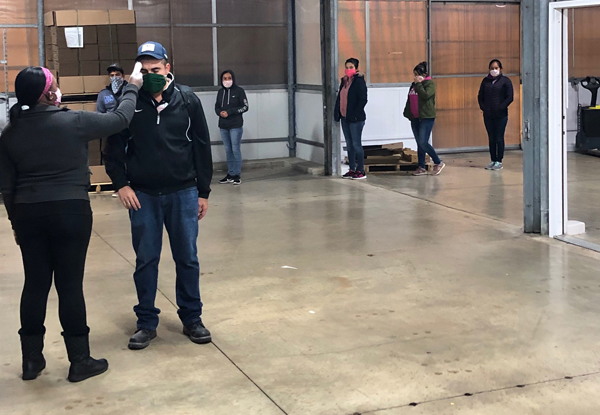
Employees practice social distancing while waiting for temperature scans and a nurse’s check before the start of their shift.
“At our first management meeting on this, we talked about what we could do as a team and realized that we would be more effective if we explained why we’re doing what we’re doing, because we were going to ask employees to make some major changes,” he explains.
Four Star’s managers then asked employees for their input and ideas. The first goal was for Four Star to do its part to help flatten the curve. This quickly evolved into ways to “help the employees feel like they are the valued resource that they are,” says Heulitt. “It means recognizing the importance of staying healthy and each employee’s role in keeping themselves healthy.”
“We already have the reputation as a clean grower, so in some respects, our practices were already ahead of the curve,” says Jeff Back. “For instance, we already clean our production facilities extensively and use sanitary practices in our operations. We already have hand sanitizer stations, and many of our processes require gloves and protective gear for sanitary purposes. The next step was putting those processes in place in the common areas, break rooms and offices.”
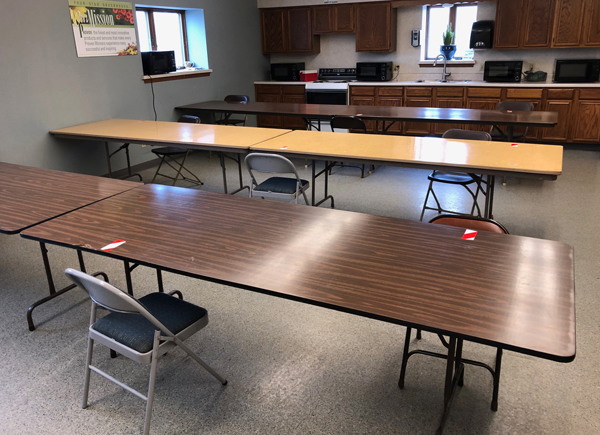
Smaller shifts and staggered break times let employees social distance in the break room.
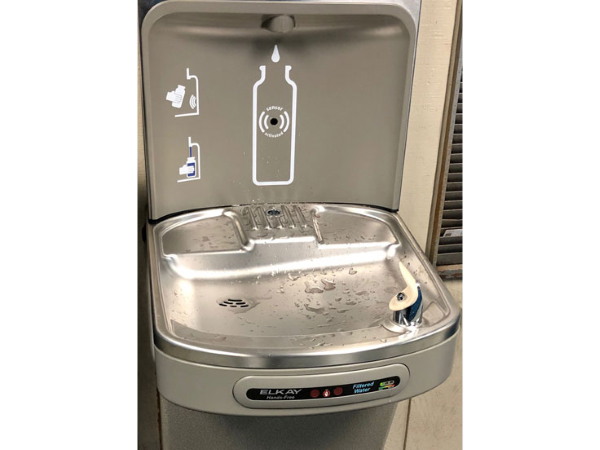
All fountains and sinks at Four Star are being converted to touchless operation.
“Everything was a team effort,” recalls Heulitt. “Employees offered ideas and quickly took on new responsibilities. In one instance, employees pointed out that we had outside contractors doing some work in the facilities and that they needed to follow our safety practices. So we developed a contractor protocol that they sign off on now.”
“We told employees we appreciate their ideas and suggestions,” adds Back. “When we first started this, we had employees put bright yellow dots on places that got a lot of touches from everyone. We were surprised at how many places there were – cabinets, microwaves, doors, vending machines, garbage can lids, etc. We keep the dots on now to remind people that these are frequently touched surfaces and that they should wash their hands after touching them.”
Some of the first priorities were to make changes that eliminate multiple touches, and that effort continues. Four Star propped open doors, removed lids or doors on trash cans, and is converting all fountains and sinks to touchless operation. Early on, Four Star supplied each worker with two bandanas as face coverings when face masks where in short supply.
Soon after, the company brought in nurses to check employees’ health and monitor their temperatures at the start of each shift. The nurses remain on site through the shift so they are available to consult with employees or address any concerns. “We want our employees to be reassured by this,” says Back.
Some of these changes involve a considerable financial investment, Back notes. “It’s a big expense to convert everything to touchless, but we look at it as an investment in the future. These are changes we’ll keep around going forward to help keep workers healthy, so how can that be bad?”
Concern for employee safety
Four Star recently installed video monitors throughout the facility that enable the management team to communicate important news and information to employees. This has come in handy as circumstances evolve and new information surfaces.
“We’ve used this system to share updates and information on how they can continue to be safe and healthy both at work and at home,” says Heulitt. “We also have this information available for remote employees on our website.
“From the first day, our company leadership embraced these efforts because they’ve always seen employees as our most valued resource,” he notes. “This has allowed us to make decisions and move quickly to implement them, and the company sees that. Teams stepped up to help with new tasks, like sourcing and distributing disinfectant cleaners to everyone, creating labels and signs, mixing cleaners, relocating equipment and reshuffling work teams.”
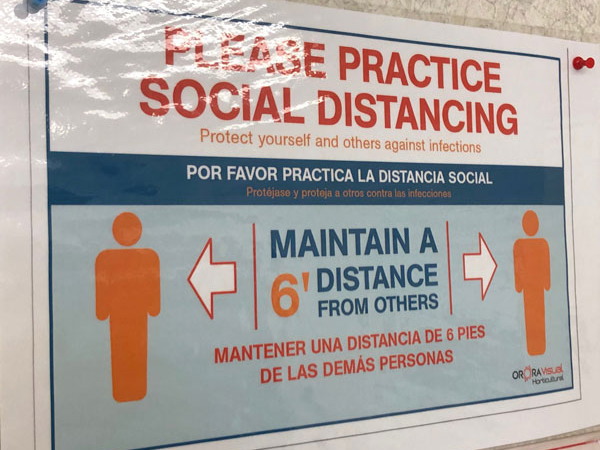
Signs throughout the facility remind people to practice social distancing.
“Tom and Sharon Smith told us, ‘We want our employees to feel safer here than anywhere,’ and we stand behind that,” Back comments. “Some employees were nervous about coming in when this started but as soon as we got the nurses in to check everyone’s health daily, they started feeling reassured. I joined the nurses first thing in the morning, greeting everyone. We want employees to get the message that we’ve got their backs.”
“Polls show people want to make sure that their workplaces are safe,” Heulitt points out. “And consumers want safe places also. So, anything we can do to make them feel safe is a benefit and is well worth it. We encourage face coverings and frequent cleanliness. At the same time, we also encourage our employees to take responsibility for their own health by exercising, eating well, getting enough sleep.”
Congestion point strategies
A major concern was the fact that employees often gathered closely together during breaks in the break room, near lockers, in hallways, in restrooms and even along production lines. To help space people apart, Four Star devised several strategies, including:
- “We added extra shifts, which we didn’t do much before, to minimize the number of people working at any one time,” Heulitt explains. “Some of the shipping and production areas were very crowded, so this helped to make them less so.”
- Shifts and work teams have been realigned. Some employees used to go back and forth to work at both Four Star’s adjacent facilities before this effort. Now, they work only at one facility.
- “Everyone who can work remotely is now doing that, which is dozens of people,” says Heulitt. “I give major kudos to our IT department who got all those people up and running remotely in just a few days!”
- Areas where lockers and vending machines were located created a lot of congestion. “Thanks to the maintenance team, those things were quickly relocated to make more room,” he adds.
- Employees developed new ways to handle equipment where they formerly stood close together, such as pulling Dutch flower carts around the greenhouses. Now, instead of two people pulling, one pulls and the other pushes from the other end.
- Breaks are staggered, and the break room is set up to limit the number of people at any one time.
- Time clocks required spaced marks on the floor and a supervisor to assist with check-in to minimize contact. Four Star used spaced floor marks near glove stations also.
- Restroom breaks are staggered and floors are marked where employees should stand to keep apart.
- Some shipping and loading practices were changed to allow workers more room to space apart.
- “We shut down every other sticking station to give employees more room,” says Back.
- Physical plexiglass barriers were installed along the shorter production lines where space was not available, which allow workers to see each other but work at a safe distance.
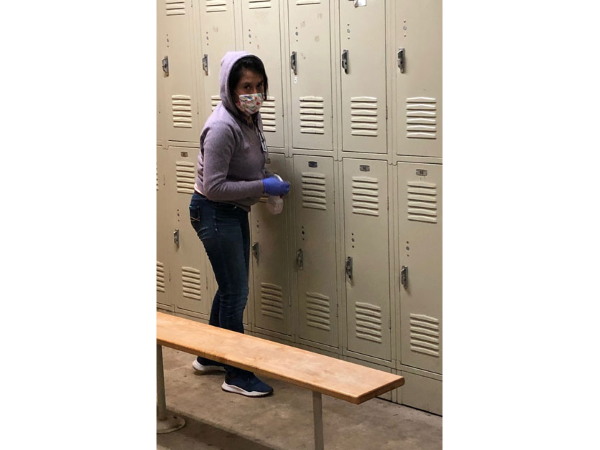
An employee regularly disinfects surfaces and handles, such as these lockers.
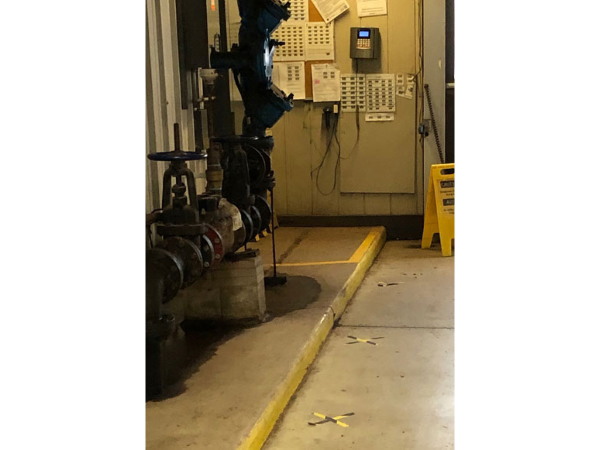
Marks on the floor show employees where to stand while the supervisor checks them in at the time clock.
“It has been a team effort throughout,” says Back. “My department had so many people to divide up and teams to reconfigure, but it has ended up being more efficient.”
Advice for growers
The rapidly changing COVID-19 situation, quickly evolving government directives, and the flow of new and sometimes contradictory information has changed our lives forever. “This whole experience has taught us a lot of things,” Heulitt says. “For instance, we’ve gotten used to the fact that this IS an evolving situation and many of the changes we are making now will be with us in the short term and maybe longer.”
While some changes have had the added benefit of enhancing efficiency, that isn’t the main goal, he notes. “We encourage everyone to think about these three things: Safety takes precedence over awkward feelings (like wearing a mask or asking coworkers to move further apart); creativity takes precedence over habit so we’re forced to rethink things creatively; and an abundance of caution takes precedence over efficiency.”
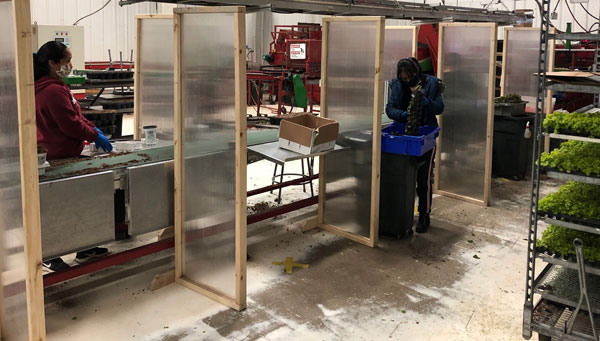
Plexiglass panels along the production line keep employees safely spaced apart from each other.
Back agrees, “Employees really do appreciate the efforts made to keep them safe. I’ve heard a lot of thank yous from them.”
He notes that growers on a tight budget can make meaningful changes that will benefit them and their employees. “It’s never too late to start looking for ways to make your workplace safer,” he says. “And you don’t need to do everything at once. Start with small steps and get your employees involved. Most of those changes are things you’ll want to have going forward. There’s no downside to that!”
For more informatio n:
n:
Four Star Greenhouse
734-654-6420
info@pwfourstar.com
www.pwfourstar.com
